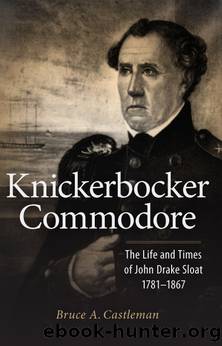Knickerbocker Commodore by Bruce A. Castleman

Author:Bruce A. Castleman [Castleman, Bruce A.]
Language: eng
Format: epub
Tags: Biography & Autobiography, Military, History, Naval, United States, 19th Century
ISBN: 9781438461519
Google: 8a8rDAAAQBAJ
Publisher: SUNY Press
Published: 2016-05-12T00:44:32+00:00
CHAPTER THIRTEEN
Mexican California
Commodore John Drake Sloat continued on to Peru from Panama in the schooner Shark and arrived in Callao by early January 1845. James K. Polk won the presidential election that took place a few weeks after Sloat left to assume command of the Pacific Squadron. Polk would take more aggressive action than had his predecessor John Tyler to acquire what has become the southwestern United States.1 The United States had finally annexed Texas just before Tyler left office, but Mexico had also felt pressure on its department of California for many years.
Sloat had last been to Mexico in 1830, when the St. Louis spent several weeks in Mazatlán and San Blas on the Pacific coast. In 1824, he took the Grampus to the Gulf of Mexico ports of Campeche, Veracruz, and Tampico, and he had also called as a merchant skipper at least once at Campeche before Mexicoâs independence wars began. He had never been to California. At this point, it is useful to interrupt the narrative biographical sequence for a consideration of cultural, economic, and political aspects of the California society that Sloat would encounter upon his arrival in Monterey. This chapter will first draw upon the substantial body of scholarship that shapes todayâs understanding of Californios and their world, and then consider the lenses and notions through which Sloat and his colleagues created their own ideas of what and whom they were dealing with.
Spanish claims in western North America went back for several centuries, but the area north of about thirty-two degrees North latitude had been only occasionally traversed by explorers serving the kings of Spain. The treaty that ended the Seven Yearsâ War in 1763 extended Spanish sovereignty over French North American territory lying west of the Mississippi River. Written in a far-off European capital by diplomats looking at maps on walls, this treaty had little meaning to peoples such as the Miwoks, the Yokuts, or the Chumash who actually lived on present-day California lands and believed them to be their own. Their lives would soon change as forces began to converge upon them.
The viceroyalty of New Spain, the pre-independence antecedent of Mexico, included todayâs Mexican republic, the Central American republics except for Panama, and western North America with a very vaguely defined boundary on its north. From his seat in México, the capital city and vital center of the kingdom of New Spain, the Spanish viceroy served as a surrogate for the king in Madrid. In the latter part of the eighteenth century, King Charles III (r. 1759â1789) began a series of changes to strengthen government in Spain and in its empire that are collectively known as the Bourbon reforms. One concern was protecting Mexican silver mines from capture by the British. In an eerily prophetic report, a Spanish military commission reported to the viceroy in 1774 that the only realistic British threat at that time was through Veracruz, but given the well-known nature of the North American colonists, one might materialize on the northern frontier perhaps fifty years later.
Download
This site does not store any files on its server. We only index and link to content provided by other sites. Please contact the content providers to delete copyright contents if any and email us, we'll remove relevant links or contents immediately.
Machine Learning at Scale with H2O by Gregory Keys | David Whiting(4183)
Never by Ken Follett(3794)
Harry Potter and the Goblet Of Fire by J.K. Rowling(3775)
Unfinished: A Memoir by Priyanka Chopra Jonas(3333)
Fairy Tale by Stephen King(3220)
The Man Who Died Twice by Richard Osman(2997)
Will by Will Smith(2793)
Rationality by Steven Pinker(2291)
The Dark Hours by Michael Connelly(2245)
Can't Hurt Me: Master Your Mind and Defy the Odds - Clean Edition by David Goggins(2228)
It Starts With Us (It Ends with Us #2) by Colleen Hoover(2198)
The Storyteller by Dave Grohl(2172)
The Dawn of Everything: A New History of Humanity by David Graeber & David Wengrow(2122)
Friends, Lovers, and the Big Terrible Thing by Matthew Perry(2119)
The Becoming by Nora Roberts(2088)
The Stranger in the Lifeboat by Mitch Albom(2050)
Cloud Cuckoo Land by Anthony Doerr(2035)
Einstein: His Life and Universe by Walter Isaacson(1967)
Love on the Brain by Ali Hazelwood(1965)
